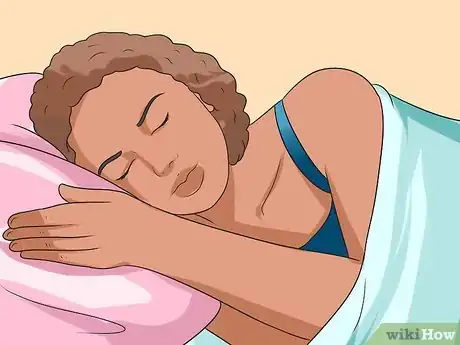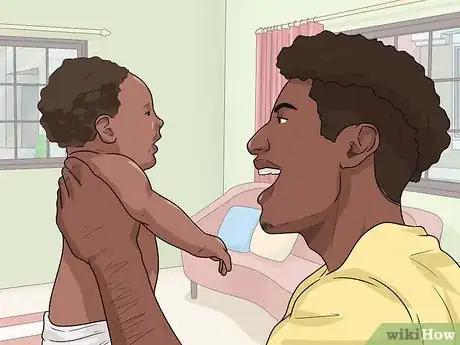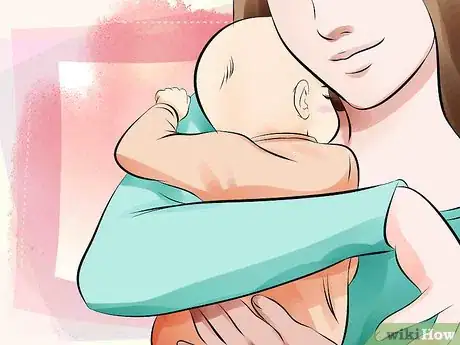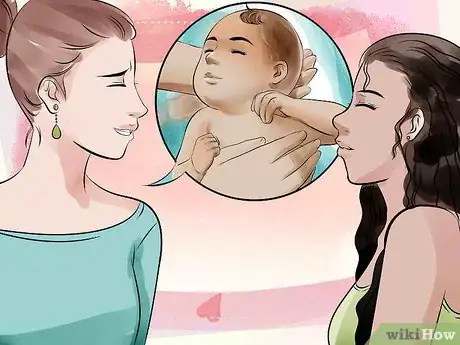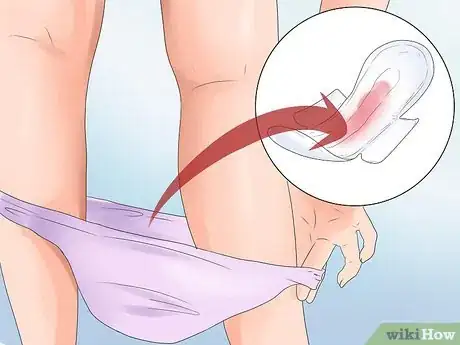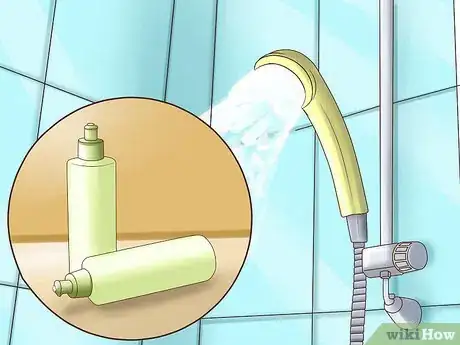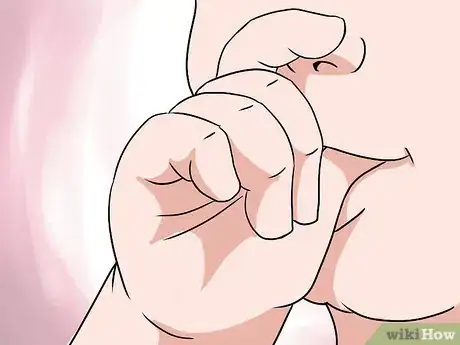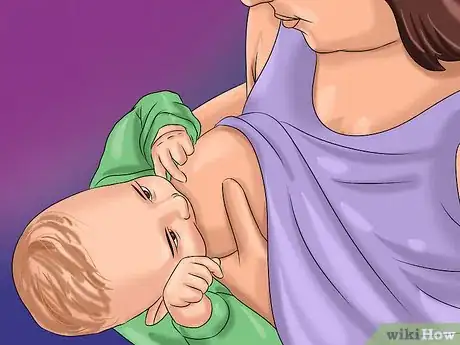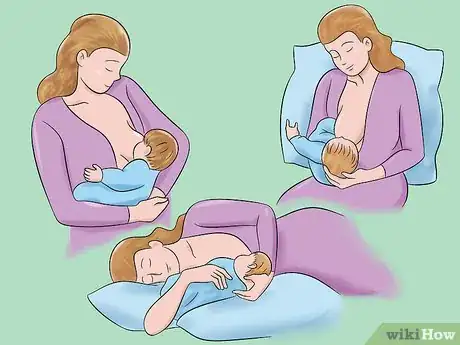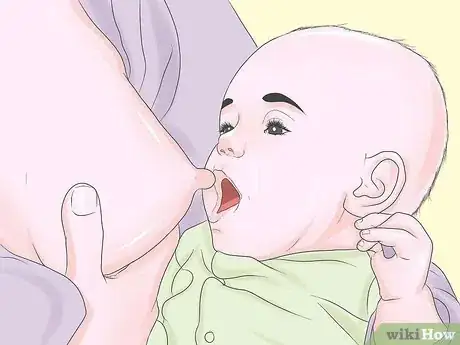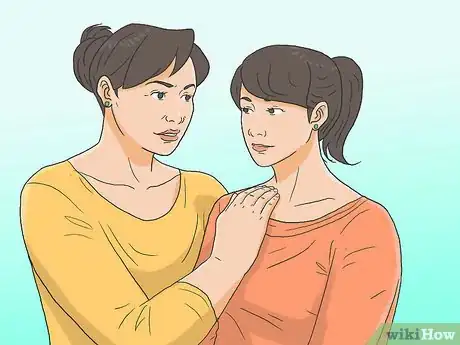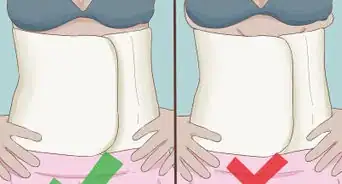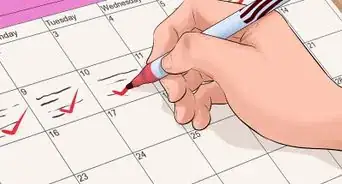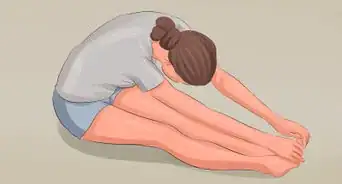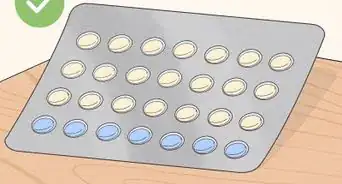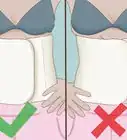This article was co-authored by Carrie Noriega, MD. Dr. Noriega is a Board Certified Obstetrician & Gynecologist and medical writer in Colorado. She specializes in women’s health, rheumatology, pulmonology, infectious disease, and gastroenterology. She received her MD from the Creighton School of Medicine in Omaha, Nebraska and completed her residency at the University of Missouri - Kansas City in 2005.
There are 13 references cited in this article, which can be found at the bottom of the page.
This article has been viewed 91,357 times.
The first week after birth is an exciting and exhausting time. Both you and your baby will be bonding. At the same time, you will be recovering emotionally and physically from the birth. There are many things you can do to help yourself adjust to this new phase of life and to heal. Don't be afraid to ask for help from family, friends, and resources in your community if you need it.
Steps
Dealing with Your Emotions
-
1Get as much sleep as you can. Your baby will wake up every few hours to eat. The best way to get sleep is to sleep when your baby sleeps. This may include making up for your deficit by napping during the day. Getting enough rest will also help your body produce milk.[1]
- You will likely feel physically exhausted from the exertion of the birth and emotionally exhausted from the excitement. This is normal and you will feel better as your body heals.
- If you have older children that also need attention and supervision, consider asking family members or friends to babysit. This will enable you to sleep for a few hours during the day.
-
2Encourage your partner to help you. Your partner may be unsure what to do or may feel left out if you don’t have a family room where they can stay overnight with you and the baby in the hospital.[2]
- Give your partner plenty of time to cuddle with the baby. Talk with your partner about how you both feel after the birth, since your lives are going through a big transition.
- If you are still in bed recovering, let you partner bring the baby to you so you don’t have to get up to nurse. Your partner can also change the baby’s diaper, bathe the baby, and dress the baby.
- Ask your partner to supervise any older children you might have as well. If your older child is big enough, your partner can explain how to hold the baby and supervise the initial bonding period between the siblings.
Advertisement -
3Recognize the baby blues. Many women feel sad, exhausted, or cry around three to five days after the birth. This can happen because of the hormonal changes your body is going through. You are particularly vulnerable to the baby blues if you are very tired, the birth was difficult, or your your recovery is preventing you from taking care of your baby the way you want to. The baby blues are normal and pass after one to two weeks. Symptoms include:[3] [4]
- Being extremely emotional
- Reacting irrationally
- Crying without an apparent cause
- Feeling irritable
- Feeling anxious or stressed
- Feeling depressed
- Loss of appetite
- Finding it difficult to make choices
-
4Identify postpartum depression. Postpartum depression is different from the baby blues because it is more severe and doesn’t pass after a week or two. It usually starts two weeks to two months after the baby’s birth, but it can also start sooner or even a year after birth. One in 10 women and four in 10 teenage mothers can experience postpartum depression. If you think you may have postpartum depression or if a friend or family member thinks you may have it, talk to someone you trust and contact your doctor. Symptoms include:[5]
- Loss of interest in the baby
- Crying
- Lack of pleasure
- Lack of concentration
- Feeling that you can’t cope
- Memory loss
- Anxiety or panic attacks
- Exhaustion
- Insomnia
- Achiness
- Lack of hunger
- Post traumatic stress disorder may also occur after a painful or difficult delivery
-
5Give yourself time to bond with your baby. Not all women experience love at first sight when they see their babies. Give yourself time to bond and it will come.[6]
- This doesn’t make you a bad mother or an incapable mother. The love will come as you bond over time.
- You can still provide your baby with everything they require as you bond.
- Include any older children you have in your bonding. An older child can sit with you as you hold the baby or cuddle with you both as you nurse. Explain to the older child that they will now be a big brother or big sister and that the younger sibling will look up to them. Then, when the baby is bigger, they can play together.
-
6Join a new mothers' group. This will enable you to get support from women who are going through the same process that you are. You will be able to:
- Trade tips on breastfeeding and solving the day to day puzzles that are part of your new phase of life.
- Make new friends.
- Get support which will help buffer you against postpartum depression
-
7Ask for help when you need it. The first week after birth is a time when you will naturally feel overwhelmed. Even a small amount of help from friends and family can go a long way to making things feel more manageable and giving you time to also take care of yourself. This help could include:
- Friends bringing you meals so that you don't have to cook. Or alternatively, you may have relatives that can come and stay with you for a few days and cook. They can also freeze food so that you won't have to cook for a few days after they go home.
- A family member holding the baby while you shower. Family members can also diaper the baby, burp the baby, and dress the baby. They can also help supervise older children while you nurse and take care of yourself.
Healing Your Body
-
1Notice the changes your body is going through. Your body is simultaneously healing and adjusting to not having the baby inside anymore. You will notice that:[7]
- Your abdomen will feel loose and baggy because the muscles and skin have stretched out. It will slowly return to normal.
- Breastfeeding helps your uterus to contract. If you feel cramps that feel similar to when you have your period, this may be why. If it is very uncomfortable, tell your doctor.
-
2Wear pads to absorb vaginal bleeding. In the first few days it will be heavy. Over time it will be browner and then lighter. At the end the discharge may be yellow or white. This may last for six weeks.[8] [9]
- Call your doctor if you have a fever and pass large clumps of blood or if it smells bad.[10] You should also call the doctor if you bleed through more than one large pad in an hour for more than two consecutive hours.
- Try witch hazel. The hospital may also give you witch hazel pads that you can put between a sanitary pad and the wound. This will help promote healing.[11] You can also purchase postpartum bath teas. These are mixtures of healing herbs that you can put in your bath.
- Don’t use tampons because the tissues are healing.[12] Tampons also raise your risk of an infection.
-
3Bathe your stitches in warm water after an episiotomy. If you had tearing or were cut to help the baby out (episiotomy), the doctors may have sewn you up with stitches. Most hospitals will give you a "peri-bottle" which you can fill with warm water and use to rinse your perineum after you urinate. This will help keep the area clean.[13] [14]
- If it is uncomfortable, sit carefully and lie on your side instead of your back. You can also purchase a padded ring on which you can sit. This relieves the pressure around your vagina.[15]
- If you are breastfeeding, talk to your doctor before you take any painkillers, even over-the-counter painkillers. Your doctor will be able to tell you what medications will or won’t be safe for your baby while you nurse.
- If the stitches hurt during bowel movements, you can hold a clean pad over them to support them. Try not to push too hard when you are having bowel movements. Eat fresh produce, salads, and whole-grain breads to increase your fiber intake. This will help your stool stay soft. Drink extra water as well. If this isn’t enough, your doctor may recommend stool softeners.[16]
- The stitches usually dissolve on their own and generally don’t have to be removed. Contact your doctor if the pain gets worse or if the cut or tear gets inflamed or seeps pus.[17]
-
4Don’t worry if you leak a little urine. After birth women often find that they may leak some urine if they laugh or cough. It may be tempting to drink less water so that you don’t have to pee as often, but don’t do that. If you dehydrate yourself it will also reduce your milk production. Drink at least eight cups of water per day.[18] [19]
- Doing pelvic floor or Kegel exercises will help you get the muscles back into shape. Once you have healed you can start. Tighten the muscles that you use when you are stopping the flow of urine midstream and then release them quickly. Repeat this several times. As you get stronger you will be able to do more repetitions. You can also do repetitions where you squeeze and hold for 10 seconds.[20] [21]
- Contact your doctor right away if you have signs of a urinary tract infection such as the feeling that you always have to pee;a painful, burning feeling when you do pee; or frequently passing only a little bit of urine.[22]
-
5Don’t strain during bowel movements if you have hemorrhoids. Hemorrhoids are stretched veins around your anus.[23] They can be painful, but usually heal after a few days.[24]
- Your doctor may be able to give you an ointment that you can put on which will ease the discomfort.
- Increase your fiber intake by eating whole-grains, fresh vegetables, fruits, and salads. Drink extra water. This will help to keep your stool soft and reduce the discomfort when you have bowel movements.
-
6Give yourself time to recover after a cesarean birth. You will probably need to stay a few extra days in the hospital, possibly up to three days. If you have help at home, you may be able to go home after 24 hours. During the first week you should:[25]
- Rest as much as you can. This can be either bed rest or sleeping.
- Walk around a little bit each day to lower your risk of getting a blood clot. It doesn’t have to be far or strenuous, just enough to make sure your blood is circulating properly. This will also help relax your muscles. Ask your doctor or midwife how much walking they recommend for you.
- Try not to go up and down stairs more than necessary because this strains your stomach muscles. Wait until your doctor tells you that you are ready before driving, exercising, lifting heavy objects, or having sex.
- Follow your doctors instructions for cleaning the wound and changing any dressings.
Getting Comfortable Breastfeeding
-
1Recognize signs of hunger in your baby. At first your baby will want to drink frequently, possibly even once per hour. The first milk your body makes will be colostrum. It is often slightly yellow and it is very concentrated. Your baby will probably only drink about a teaspoon at each meal. You will notice that your baby is hungry when they:[26]
- Move their head around looking for the breast
- Make sucking motions. Many babies suck their fingers.
- Cry or fuss.
-
2Help your baby latch on properly to your breast. Using the correct feeding position will help your baby drink easily. You can do this by:[27]
- Holding your baby close so that their nose is at your nipple.
- Softly rubbing their upper lip to encourage them to open their mouth wide and keep their tongue down.
- Bring them to your breast as they tip their head back. Your nipple should go into their mouth towards the roof of their mouth and they should have a large mouthful of nipple.
-
3Try out different breastfeeding positions. This will help you to figure out what works best for you and your baby. Different positions to try include:[28]
- Cross-cradle hold. Hold the baby with the arm that is opposite from the breast they are feeding from. Support their head with your hand. Use your free hand to support your breast. Bring the baby to you, instead of leaning towards the baby.
- Cradle hold. Cradle the baby in the arm that is on the same side as the breast you are giving the baby.
- Football hold. This position is good for women who just had a C-section because the baby doesn’t rest on your belly. Hold the baby like a football at your side on the same side as the breast that you are offering. The baby’s feet will be towards your back.
- Side-lying hold. Lie on the bed with your baby next to you. You should be tummy to tummy with your baby. This position can be good for night feedings — just be sure to return the baby to their own bed when you both go back to sleep.
-
4Develop a routine as your milk comes in. After about two to four days, your breasts will become warmer and enlarged with milk. As your baby drinks your milk supply, your body will make more. You should breastfeed as often and as long as the baby wants. This is called baby-led feeding.[29]
- You should breastfeed both during the day and at night.
- While breast milk is healthiest for the baby, not all women can or want to breastfeed. It is also possible for you to give your baby the nutrients they need through formula.
- You will know that your baby is getting enough milk when they are satisfied after their meals, gains weight, urinates at least six times per day and passes yellow stool twice per day.[30]
-
5Ask for help if you need it. It can take a little while for you and your baby to figure out what techniques work best for you both. If you are having difficulties, there are many resources that you can reach out to. This can include:
- Asking an experienced female relative or friend
- Requesting assistance from a lactation consultant at the hospital. Many hospitals offer free lactation advice, even after you are discharged. This may even include having someone come to your house and help you or a hospital-supported breast feeding group.
- Talking to your midwife
- Hiring a private lactation consultant
- Going to La Leche League meetings. The La Leche League is a global organization that is dedicated to helping mothers breastfeed. They offer support in many different languages.[31] You can check online to see if there are meetings in your area. If not, you may be able to get help through online forums or over the telephone.
References
- ↑ https://www.stanfordchildrens.org/en/topic/default?id=the-new-mother---taking-care-of-yourself-after-birth-90-P02693
- ↑ https://www.stanfordchildrens.org/en/topic/default?id=the-new-mother---taking-care-of-yourself-after-birth-90-P02693
- ↑ http://www.nhs.uk/conditions/pregnancy-and-baby/pages/you-after-birth.aspx#close
- ↑ http://www.nhs.uk/Conditions/pregnancy-and-baby/pages/feeling-depressed-after-birth.aspx
- ↑ http://www.nhs.uk/Conditions/pregnancy-and-baby/pages/feeling-depressed-after-birth.aspx
- ↑ https://www.helpguide.org/articles/parenting-family/building-a-secure-attachment-bond-with-your-baby.htm
- ↑ https://my.clevelandclinic.org/health/articles/9682-pregnancy-physical-changes-after-delivery
- ↑ http://www.mayoclinic.org/healthy-lifestyle/labor-and-delivery/in-depth/postpartum-care/art-20047233
- ↑ https://www.nlm.nih.gov/medlineplus/ency/patientinstructions/000628.htm
- ↑ https://www.nlm.nih.gov/medlineplus/ency/patientinstructions/000628.htm
- ↑ http://www.mayoclinic.org/healthy-lifestyle/labor-and-delivery/in-depth/postpartum-care/art-20047233
- ↑ https://www.nlm.nih.gov/medlineplus/ency/patientinstructions/000628.htm
- ↑ http://www.mayoclinic.org/healthy-lifestyle/labor-and-delivery/in-depth/postpartum-care/art-20047233
- ↑ http://www.nhs.uk/conditions/pregnancy-and-baby/pages/you-after-birth.aspx#close
- ↑ http://www.mayoclinic.org/healthy-lifestyle/labor-and-delivery/in-depth/postpartum-care/art-20047233
- ↑ http://www.mayoclinic.org/healthy-lifestyle/labor-and-delivery/in-depth/postpartum-care/art-20047233
- ↑ http://www.mayoclinic.org/healthy-lifestyle/labor-and-delivery/in-depth/postpartum-care/art-20047233
- ↑ http://www.nhs.uk/conditions/pregnancy-and-baby/pages/you-after-birth.aspx#close
- ↑ https://www.nlm.nih.gov/medlineplus/ency/patientinstructions/000628.htm
- ↑ http://www.nhs.uk/Conditions/pregnancy-and-baby/pages/pregnancy-exercise.aspx#pelvicfloor
- ↑ http://www.mayoclinic.org/healthy-lifestyle/labor-and-delivery/in-depth/postpartum-care/art-20047233
- ↑ http://www.mayoclinic.org/healthy-lifestyle/labor-and-delivery/in-depth/postpartum-care/art-20047233
- ↑ http://www.mayoclinic.org/healthy-lifestyle/labor-and-delivery/in-depth/postpartum-care/art-20047233
- ↑ http://www.nhs.uk/conditions/pregnancy-and-baby/pages/you-after-birth.aspx#close
- ↑ http://www.nhs.uk/Conditions/Caesarean-section/Pages/Recovery.aspx
- ↑ http://www.nhs.uk/Conditions/pregnancy-and-baby/Pages/breastfeeding-first-days.aspx
- ↑ http://www.nhs.uk/Conditions/pregnancy-and-baby/pages/breastfeeding-positioning-attachment.aspx
- ↑ http://www.mayoclinic.org/healthy-lifestyle/infant-and-toddler-health/multimedia/breast-feeding/sls-20076017
- ↑ http://www.nhs.uk/Conditions/pregnancy-and-baby/Pages/breastfeeding-first-days.aspx
- ↑ http://www.nhs.uk/Conditions/pregnancy-and-baby/pages/breastfeeding-positioning-attachment.aspx
- ↑ http://www.llli.org/
